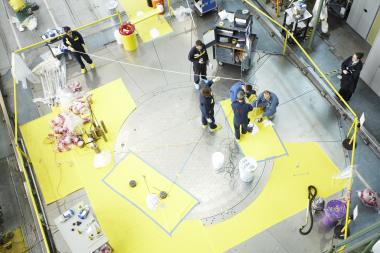Canada's nuclear regulator has approved the return to service of one of the world's major radioisotope producing reactors, the National Research Universal (NRU) reactor at Chalk River, after extensive repairs.
 |
| Inspection work in progress at NRU (Image: AECL) |
A heavy water leak from the reactor vessel at NRU was discovered in May 2009. To repair it, Atomic Energy of Canada Ltd (AECL) has had to defuel the reactor, drain its heavy water, carry out in-depth inspections, and then repair those parts of the reactor vessel where corrosion had caused structurally significant thinning of the vessel wall. This entailed the development of specialised tools to carry out the work, with operatives then being trained to use the equipment and qualification of the techniques being carried out on full-height mock ups of the NRU vessel constructed at the Chalk River site. AECL has also been required to develop a strategy to mitigate future corrosion problems.
Now, after an expedited one-day hearing where it considered recommendations from its own staff as well as submissions from AECL and other intervenors, national regulator the Canadian Nuclear Safety Commission (CNSC) has given its approval for AECL to go ahead with restarting the reactor.
The cause of the leak
AECL senior vice-president and chief nuclear officer Bill Pilkington told the hearing that the corrosion was a result of nitric acid formed by irradiation of air in the presence of light water from reflector leaks. The delivery of carbon dioxide (CO2) into the annulus - a six-inch (15 cm) wide sealed zone around the reactor vessel that acts as a buffer - to displace air had not always been effective, he said. Thus, a strategy to reduce and arrest corrosion based on reducing air and water ingress had been developed, with immediate action taken to address water leaks, reduce air leaks and to improve delivery of CO2.
Going forward, Pilkington said, CO2 purity and the pH of water drained from the annulus would be closely monitored, while physical improvements during regular planned maintenance outages would enable water and air ingress to be reduced still further. Additional mitigation measures, including the application of a cold spray sacrificial aluminium coating, repair of reflector leaks and changes to reflector water chemistry, are under consideration. The unit will also undergo longer scheduled annual maintenance outages in future, with the first one to take place within nine months of the unit's restart. The CNSC has instructed AECL to provide six-monthly updates on the progress and effectiveness of its action plan.
Return-to-service activities are under way at the reactor which is now expected to resume isotope production by the end of July. The extended outage of NRU, which produces 40% of the world's molybdenum-99, has had a significant impact on the world's supply of radioisotopes. Indeed, Canadian radioisotope distributor MDS Nordion recently reported a fall in revenues to $56 million for the second quarter of 2010 against $65 million for the same quarter in the previous year primarily due to the continued unavailability of NRU.
Researched and written
by World Nuclear News





_18570.jpg)
_16159.jpg)
_49205.jpg)





